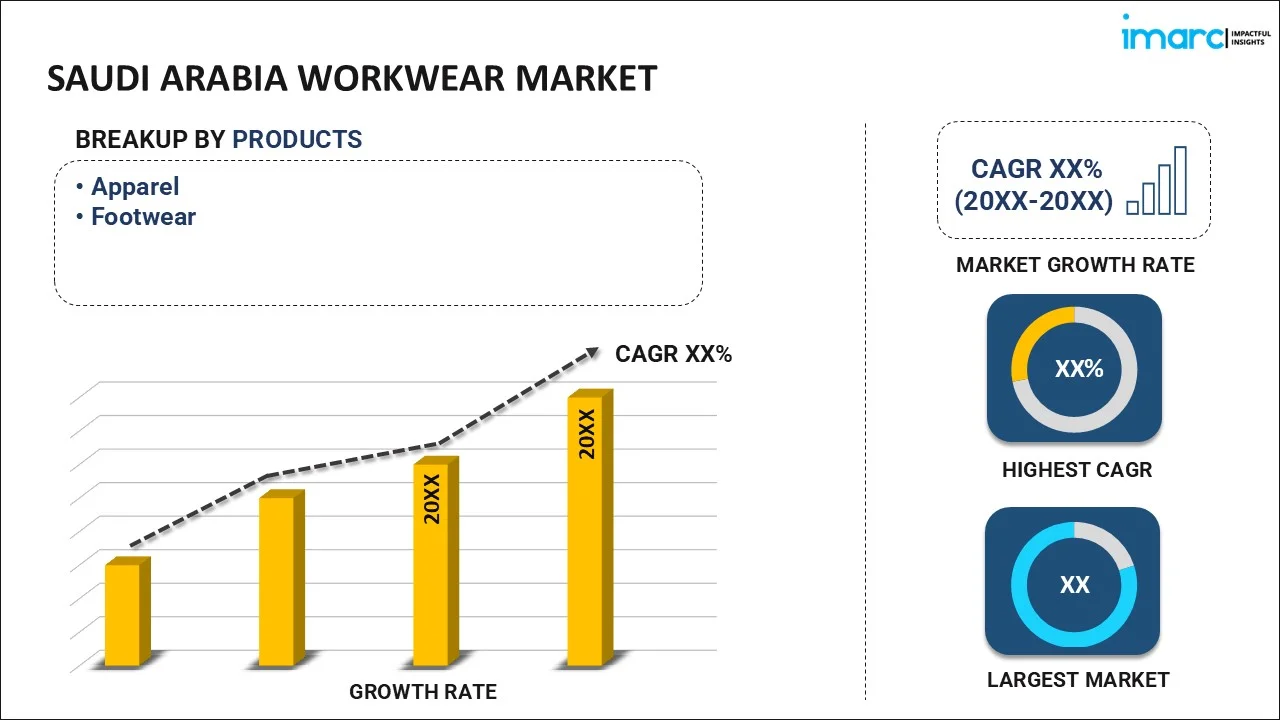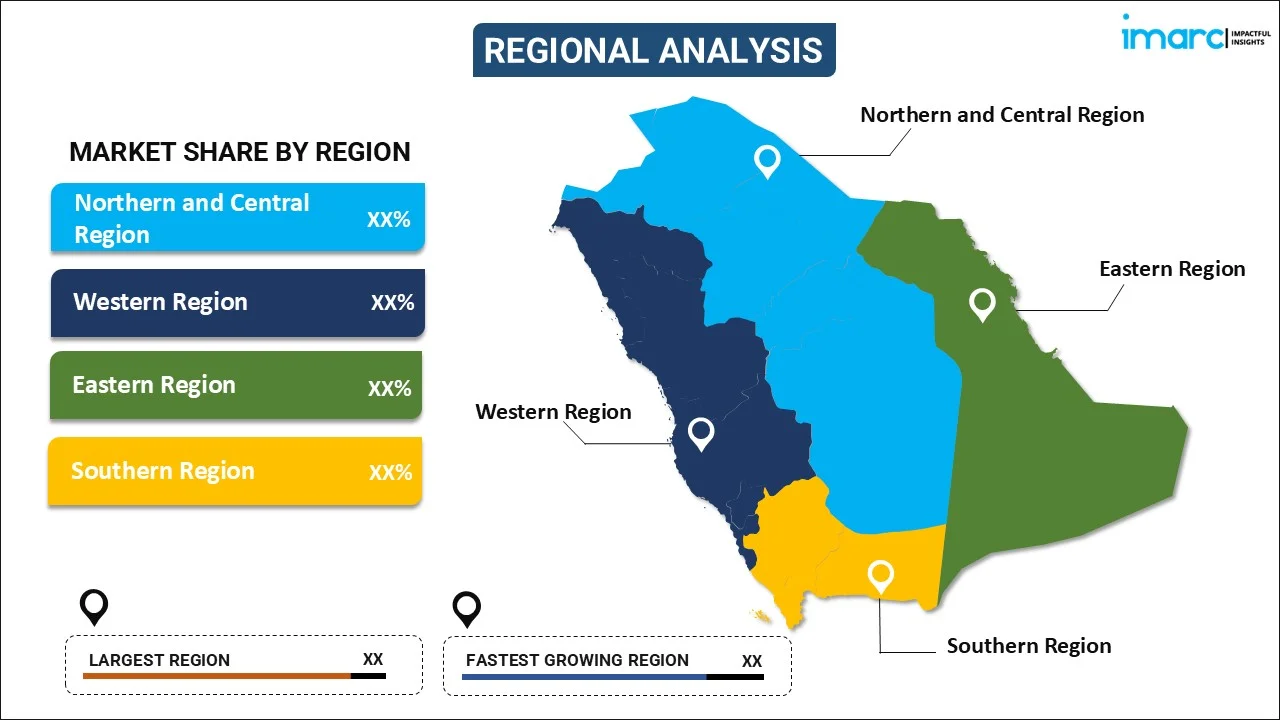
Saudi Arabia Workwear Market Size, Share, Trends and Forecast by Product, Application, Distribution Channel, End User and Region, 2025-2033
Saudi Arabia Workwear Market Overview:
The Saudi Arabia workwear market size reached USD 0.18 Billion in 2024. Looking forward, IMARC Group expects the market to reach USD 0.28 Billion by 2033, exhibiting a growth rate (CAGR) of 5.19% during 2025-2033. The market is growing due to rapid growth of industrial sectors like oil, gas, construction, and healthcare, rising need to protect employees and growing safety measures that escalate the demand for durable, functional, and sometimes tailored workwear nationwide.
|
Report Attribute
|
Key Statistics
|
|---|---|
|
Base Year
|
2024 |
|
Forecast Years
|
2025-2033
|
|
Historical Years
|
2019-2024
|
| Market Size in 2024 | USD 0.18 Billion |
| Market Forecast in 2033 | USD 0.28 Billion |
| Market Growth Rate (2025-2033) | 5.19% |
Saudi Arabia Workwear Market Trends:
Growth in Industrial Sector
The growth of Saudi Arabia's oil, gas, and construction industry is highly fueling the need for heavy-duty and specialist workwear. Mass projects such as NEOM and Vision 2030 projects are stimulating infrastructure development, calling for tough work clothes that can stand extreme environments and hard conditions. In the oil and gas sector, employees require protective equipment that complies with strict safety standards to protect against risks like fire, chemical exposure, and high temperatures. Saudi Arabia has an estimated 260 billion barrels of oil reserves, according to industry reports, making it a top OPEC member and major petroleum exporter. Nowadays, more than 250,000 individuals are working in the oil and gas industry, but the workforce will grow with further ongoing and projected projects and explorations. The construction industry also requires high-visibility apparel, flame-retardant fabrics, and ergonomic construction to maintain employee safety and respect local and international regulations. Apart from that, expansion in these sectors promotes innovation in workwear technology with a focus on durability, function, and comfort, contributing to workforce efficiency and compliance.
Rising Focus on Workplace Safety
Increasing emphasis on workplace safety in Saudi Arabia is driving the widespread adoption of protective workwear across multiple industries such as healthcare, manufacturing, and construction. An enhanced awareness of occupational hazards and stricter regulations from government bodies are compelling companies to prioritize employee safety by investing in high-quality, compliant work attire. For instance, in May 2024, Saudi Arabia officially joined the ILO Convention No. 187, reinforcing its commitment to international occupational safety and health standards. The agreement emphasizes employer responsibilities, risk assessments, and preventive strategies to ensure safer workplaces. In healthcare, for example, protective gowns and gloves are essential to prevent infections, while the manufacturing and construction sectors require flame-resistant clothing, high-visibility gear, and ergonomic designs to minimize accidents and injuries. Additionally, businesses recognize that proper workwear not only ensures compliance but also boosts employee morale and productivity. This focus on safety is fostering innovation in materials and design, leading to more durable, comfortable, and functional workwear solutions that meet the rigorous demands of various work environments in Saudi Arabia.
Saudi Arabia Workwear Market Segmentation:
IMARC Group provides an analysis of the key trends in each segment of the market, along with forecasts at the regional level for 2025-2033. Our report has categorized the market based on product, application, distribution channel, and end user.
Product Insights:

- Apparel
- Footwear
The report has provided a detailed breakup and analysis of the market based on the product. This includes apparel and footwear.
Application Insights:
- Chemical
- Power
- Food and Beverage
- Biological
- Others
The report has provided a detailed breakup and analysis of the market based on the application. This includes chemical, power, food and beverage, biological, and others.
Distribution Channel Insights:
- Supermarkets and Hypermarkets
- Specialty Stores
- E- Commerce
- Others
A detailed breakup and analysis of the market based on the distribution channel have also been provided in the report. This includes supermarkets and hypermarkets, specialty stores, e-commerce, and others.
End User Insights:
- Men
- Women
The report has provided a detailed breakup and analysis of the market based on the end user. This includes men and women.
Regional Insights:

- Northern and Central Region
- Western Region
- Eastern Region
- Southern Region
The report has also provided a comprehensive analysis of all the major regional markets, which include northern and central region, western region, eastern region, and southern region.
Competitive Landscape:
The market research report has also provided a comprehensive analysis of the competitive landscape. Competitive analysis such as market structure, key player positioning, top winning strategies, competitive dashboard, and company evaluation quadrant has been covered in the report. Also, detailed profiles of all major companies have been provided.
Saudi Arabia Workwear Market News:
- In August 2024, Riyadh Air launched its new cabin crew uniforms designed by Ashi Studio, debuting at Paris Haute Couture Week. Inspired by 1950s airline fashion, the collection features elegant cashmere outerwear and tailored looks, showcasing a blend of nostalgia and modernity.
- In June 2024, Saudi Aramco announced its plans to use advanced helmets from WakeCap that monitor heat stress and alert managers when a worker's body temperature exceeds 38°C. This initiative aims to protect workers from the extreme heat of the Gulf and enhance operational efficiency.
Saudi Arabia Workwear Market Report Coverage:
| Report Features | Details |
|---|---|
| Base Year of the Analysis | 2024 |
| Historical Period | 2019-2024 |
| Forecast Period | 2025-2033 |
| Units | Billion USD |
| Scope of the Report |
Exploration of Historical Trends and Market Outlook, Industry Catalysts and Challenges, Segment-Wise Historical and Future Market Assessment:
|
| Products Covered | Apparel, Footwear |
| Applications Covered | Chemical, Power, Food and Beverage, Biological, Others |
| Distribution Channels Covered | Supermarkets and Hypermarkets, Specialty Stores, E- Commerce, Others |
| End Users Covered | Men, Women |
| Regions Covered | Northern and Central Region, Western Region, Eastern Region, and Southern Region |
| Customization Scope | 10% Free Customization |
| Post-Sale Analyst Support | 10-12 Weeks |
| Delivery Format | PDF and Excel through Email (We can also provide the editable version of the report in PPT/Word format on special request) |
Key Questions Answered in This Report:
- How has the Saudi Arabia workwear market performed so far and how will it perform in the coming years?
- What is the breakup of the Saudi Arabia workwear market on the basis of product?
- What is the breakup of the Saudi Arabia workwear market on the basis of application?
- What is the breakup of the Saudi Arabia workwear market on the basis of distribution channel?
- What is the breakup of the Saudi Arabia workwear market on the basis of end user?
- What is the breakup of the Saudi Arabia workwear market on the basis of region?
- What are the various stages in the value chain of the Saudi Arabia workwear market?
- What are the key driving factors and challenges in the Saudi Arabia workwear market?
- What is the structure of the Saudi Arabia workwear market and who are the key players?
- What is the degree of competition in the Saudi Arabia workwear market?
Key Benefits for Stakeholders:
- IMARC’s industry report offers a comprehensive quantitative analysis of various market segments, historical and current market trends, market forecasts, and dynamics of the Saudi Arabia workwear market from 2019-2033.
- The research report provides the latest information on the market drivers, challenges, and opportunities in the Saudi Arabia workwear market.
- Porter's five forces analysis assist stakeholders in assessing the impact of new entrants, competitive rivalry, supplier power, buyer power, and the threat of substitution. It helps stakeholders to analyze the level of competition within the Saudi Arabia workwear industry and its attractiveness.
- Competitive landscape allows stakeholders to understand their competitive environment and provides an insight into the current positions of key players in the market.
Need more help?
- Speak to our experienced analysts for insights on the current market scenarios.
- Include additional segments and countries to customize the report as per your requirement.
- Gain an unparalleled competitive advantage in your domain by understanding how to utilize the report and positively impacting your operations and revenue.
- For further assistance, please connect with our analysts.

 Inquire Before Buying
Inquire Before Buying
 Speak to an Analyst
Speak to an Analyst
 Request Brochure
Request Brochure
 Request Customization
Request Customization



.webp)




.webp)












